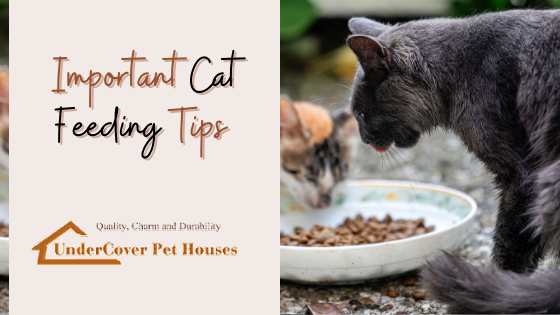 Loading... Please wait...
Loading... Please wait...Cat Feeding: Tips for Feeding Cats in Multiple Cat Households
Posted by Danny MacDonald on 2020 Nov 26th

Cats are wonderful companions, and for that reason, many households often choose to own multiple cats. While owning many cats comes with numerous benefits, many cat-owners experience difficulties, mainly when feeding multiple cats with diverse dietary needs and feeding behaviors.
This article discusses how to effectively feed multiple cats and the best methods to achieve that.
Reasons That May Require You to Feed Cats Separately
Often, situations arise where you need to ensure that your cats are separately and individually fed, so they only get their allocated food. They include;
- If one or more of your cats suffers from a medical condition requires a unique dietary plan.
- When your feline is overweight and needs a special dietary plan or needs to feed on a specific amount of food to overcome such health conditions.
- Resource guarding — When felines continuously fight over food, become aggressive, and keep others from accessing food.
- When one of your cats requires medication mixed in their regular food.
- When your felines have different ages and require different life-stage nutritional needs
Transitioning From Free-Choice Feeding
With many households having food readily available for their cats, moving to time-restricted meal feeding can be challenging for cats accustomed to free-choice feeding, but it’s completely doable. Treat each cat as an individual and make a flexible feeding routine that fits your schedule. The routine should include strategic feeding locations, specific times of day when you/or anyone else can provide regular meals as your cat learns the new routine, and meals prepared ahead of time.
To make the transition easier, pet your cat or use treats, catnip, or cat-calming pheromones to help your furry friend adjust. More importantly, don't make any sudden dietary changes without consulting your vet.
How Do You Feed Cats Separately in the Same Household?
To feed your cats separately, you can:
- Feed Your Cats in Separate Rooms
Set down rules and train your cats to feed/drink in different rooms/sections of the house. If you don't have separate rooms, place the feeding bowls far apart from one another within the feeding zone.
- Feed Each Cat at a Different Time
Monitor and feed one particular cat at a time while locking/keeping the other cats out until it's their turn to feed.
- Invest in a Feeding Station/Shelter
For cats that don't exhibit extreme aggressiveness and agility, you can invest separate in feeding stations. The feeding stations also help keep your feline's food clean and dry while keeping the cats at a physical distance.
- Invest in a Microchip Cat Feeder
Microchip feeders ensure that each cat can only access their designated food. Ideal for cats on weight-loss programs or cats with prescription diets, they prevent other cats' food theft. Microchip feeders can read a cat's microchip when they approach and open the lid if the correct kitty is identified. When your cat moves away, the feeder closes the lid.
- Invest in Interactive Feeders
Interactive feeders are a great way to prevent speedy eaters who are likely to steal food once they finish their share. Apart from helping cats feed slowly, interactive feeders also keep your cat preoccupied with their food and increases physical and mental stimulation.
Feeding multiple cats is a skill that can take time to learn. Initially, the transition might prove to be frustrating and tiresome for both you and your cats. However, with continued discipline and determination, your cats will gradually accept and embrace the new feeding routine.
